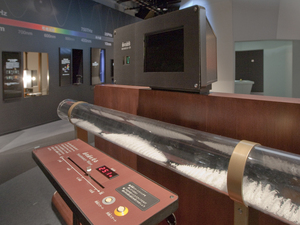Nagoya City Science Museum
TOP > Exhibition Guide > Keyword Search > Starting with "F" > frequency > Stationary Wave
Stationary Wave

Purpose of Exhibition
We want visitors to see that sound is a vibration of the air in waves.
By observing small balls jumping around in pipes at a particular volume of sound, you can recognize the correlation between pipe length and sound level. You can also recognize sound velocity from the intervals of level of sound and small spheres jumping.


Additional Knowledge
Sound is a vibration of the air and waves that transmit air. In this exhibition we have made invisible air vibration visible.
At the other side of a 2-meter pipe that is closed at one side, speakers have been installed and plenty of polystyrene balls have been inserted in the pipes. When producing sound from the speakers, if the sound level changes, suddenly the polystyrene balls jump at some points. It is at that very moment that sound turns out to be an air vibration.
[Steady Waves are Generated in the Pipe]At a particular level of sound, when the polystyrene balls jump, there is a phenomenon called resonance. When the length of sound waves and pipe length are linked, the sound from the speakers and sound reflected at the opposite sides of the pipes are neatly overlapped; so-called stationary waves are generated in the pipes. This is known as resonance condition. Waves overlapping neatly means troughs and crests of waves overlap each other: that means they are reinforcing each other.
As the phrase 'stationary waves' shows, troughs and crests of waves have settled down at particular points in the pipes. Because reinforced waves exist at some points, steady polystyrene balls in the pipe vibrate heavily. If the level of sound changes and waves do not overlap, waves weaken each other and do not settle down at one point, thus the polystyrene balls do not jump any more.
[Relationship between Level of Sound and Wave Length] When changing the level of sound, you can see the polystyrene balls jumping at some particular sound level.
At the lowest volume, the balls in the middle portion of the pipe jump highest and at both edges the balls jump much lower. It is as if there existed a crest there. As you increase the sound gradually from there, you can observe two crests at a certain level of sound. As you increase the sound, you can notice 3 or 4 crests. This shows how the length of sound waves (wave-length) shortens. Therefore, wave-lengths are short at a high volume, and long at a low volume.
[Air Movement in the Pipe]
Along the pipe length, when there are two crests in the pipe it is equivalent to a ringing sound wave-length. It will make more sense to have one crest for one wave. However, for the following reason, there are two crests for one wave.
The reason is the air-flow in the pipe. The air of the polystyrene ball crest tops vibrate right-and-left heavily. Then, the air of the portion that goes through does not move both ways. In the case of the two crests, when you take a closer look at it, you can see the crest top air at one side move left and the crest top air at the other side move right. At the next moment, the movements are reversed. Because it comes to a set of left and right movement, we believe in one wave for two crests.
Then what happens in the trough at that moment is that the air is dense because air is pushed from the crest top from left to right. Next, the air is removed from both sides. In parts of the trough, the air becomes dense or sparse repeatedly. The sound is a wave that becomes repeatedly thin and dense. And so, these kinds of waves are called compression waves. Towards the direction of the waves, condensation and rarefaction appear. Longitudinally, waves can be generated; such waves are called longitudinal waves.
We don't mention the details here, but you can notice the highest sound pressure is in the trough portion of the polystyrene balls. The portion where polystyrene balls do not move seems to be where the pressure is the highest.
[Sound Rapidness]
The velocity of sound transmission in the air is approximately 340 meters per second. You can understand the velocity of sound in this exhibition.
If you observe the sound level or two crests, 170Hzs is indicated. That means sound vibrates 170 times per second. One wave-length or the time of two crests is the same length as the pipe, about two meters.
A two meter wave is created in one second; that is the sound's speed. A two meter wave is created 170 times in one second; therefore, progressing at 340 meters, that is the speed of sound.
In 1 second 2 x 170=340[Comb-like Jumping Mystery] By observing the polyester ball crests, you may notice their comb-like shape. The reason for this shape is still a mystery.
Article by Yoshitaka Yamada, curator
